User's Guide/Help
The What Middletown Read search engine offers three different ways to search the records of the Muncie Public Library. Instructions on how to operate each of them are included below. Please be aware that the original records upon which the database rests were at times inconsistent, with misspellings, incomplete entries, and other errors. Searches should be undertaken with that in mind.
Original Manuscripts
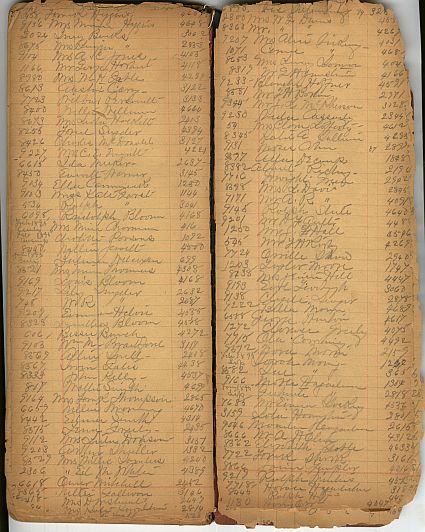 A sample manuscript from the Muncie Public Library's records. This particular sample is a page from a circulation transaction ledger.
A sample manuscript from the Muncie Public Library's records. This particular sample is a page from a circulation transaction ledger.The database includes data collected from three interconnected sets of manuscripts as described below.
Books
A two-volume Accession Catalogue (example page) includes every title (roughly 11,500) acquired and available for circulation in the library up through 1902. Each record includes the consecutive number assigned to a book when it was acquired, along with the author's name and other bibliographic information.
Patrons
Patron information is contained within a Register of Borrowers (example page) that lists every person (roughly 6,300) who joined the library from its founding in 1875 to 1902. Each record includes the consecutive number assigned to a patron, their name and address, and the name and address of their guarantor.
(Circulation) Transactions
Finally, 25 ledgers (example page) record the each of the roughly 180,000 circulation transactions that tie together the library's borrowers and the books they selected. Each line in the ledger records the number of the chosen book, the name of the borrower, and a patron number (which did not always belong to the listed borrower--see 'borrowed cards' section).
Supplemental Information
In constructing the What Middletown Read database, we supplemented the original library records with external data.
Books
Book records contain additional bibliographic information drawn from multiple sources, such as author pen names and standardized subject listings.
Patrons
Patron records contain additional information derived from Muncie city directories and the 1900 U.S. census manuscript (the closest available) whenever possible.
This supplemental data makes it possible for users to conduct searches using demographic variables such as sex, race, and occupation or to formulate queries around bibliographic categories such author, publisher, or subject.
Viewing Original Source Materials
 The original source can be viewed by clicking on a link under the 'Original Document' column
The original source can be viewed by clicking on a link under the 'Original Document' columnAll of the search results in the What Middletown Read Database include links to the original records. Listed under the "Original Documents" heading in the results tables, the "View Page" link for each record that opens a new browser window which displays a scanned version of the original MPL ledger page from which that record was retrieved. The original sources can also be accessed through Ball State University's Digital Media Repository here.
Anomalies−Gap in Records
There is one substantial gap in the available transaction manuscripts. The circulation ledgers that cover the period from May 28, 1892 to November 5, 1894 are missing. This gap encompasses a period in 1893 -1894 when the library was shuttered because of a smallpox epidemic in Muncie as well as a subsequent stretch when it did not permit books to circulate. It is possible that multiple ledgers covering this period were destroyed for fear that they could convey the smallpox infection.
Anomalies−Magazines
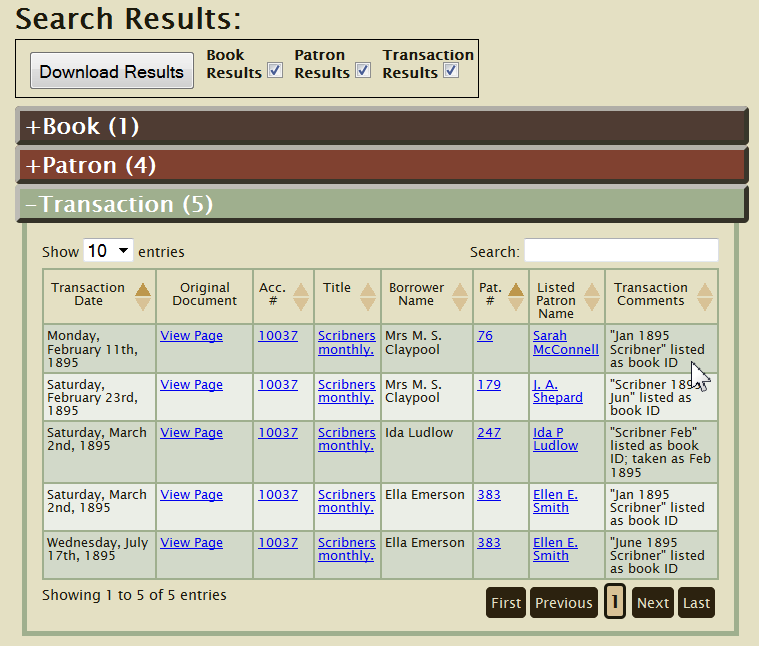 The 'Transaction Comments' field will, when appropriate, contain the title, volume, and issue information of the specific periodical checked out by the patron prior to binding.
The 'Transaction Comments' field will, when appropriate, contain the title, volume, and issue information of the specific periodical checked out by the patron prior to binding.The Muncie Public Library subscribed to a number of popular magazines during the period covered by the What Middletown Read database. Patrons were permitted to borrow both individual issues and bound volumes of these periodicals. Individual issues of magazines did not have accession numbers (which were only assigned after a magazine was bound at a later date). To record transactions involving unbound magazines, library staff simply wrote the title and issue date in the circulation ledgers (e.g "Scribners, Oct. 1895"). A search for a magazine title in the transaction comments field using the Advanced Search tool may produce additional circulation transactions involving that periodical.
To make these transactions searchable, we have assigned the accession number of the bound volume that includes the relevant issue whenever possible. However, it was not possible to document every circulation transaction involving a magazine in this fashion. The titles listed in some transaction records were illegible. Others listed issues or titles that were not bound during the period covered by available transaction records, and thus have no accession number available. Whenever a patron borrowed a single, unbound issue of a magazine, the issue date listed in the circulation ledger is recorded in the comments section included in the transaction search results.
Anomalies−"Borrowed" Cards
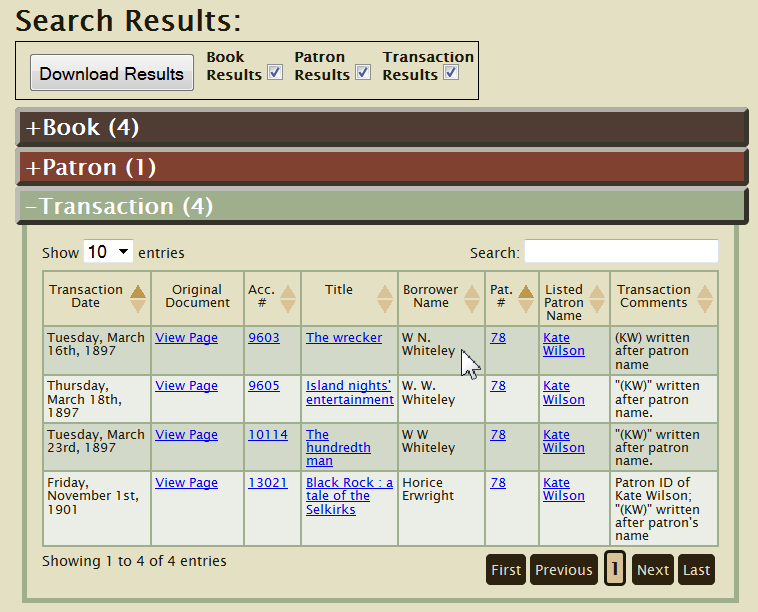 The 'Borrower Name' field displays the name transcribed from ledger manuscripts. The 'Listed Patron Name' column displays the name associated with the patron number provided in the 'Pat. #' column. In this example, 'D.C. Barrett' borrowed the patron # associated with a 'Kate Wilson'.
The 'Borrower Name' field displays the name transcribed from ledger manuscripts. The 'Listed Patron Name' column displays the name associated with the patron number provided in the 'Pat. #' column. In this example, 'D.C. Barrett' borrowed the patron # associated with a 'Kate Wilson'.When loaning materials, Muncie Public Library staff recorded the name of the borrower and a patron number, a phenomenon that we call a "borrowed card." In some instances, the borrower used a patron number that belonged to another person, evidently with the approval of the library staff. To address this issue, transactions results include both the name of the borrower ("Borrower Name") and the name associated with the patron number ("Listed Patron Name"). Comparing the "Borrower Name" field with the "Listed Patron Name" field can help users verify instances of actual "borrowed cards" as well as instances of variations on the same name (such as initials or abbreviations), misspellings, and transcription errors.
Data Summaries
The following is a list of links to various data summaries detailing specific aspects of the What Middletown Read dataset. These reports are intended to provide the user with an overview of the data contained within the project for the purpose of statistical analysis.
- Top 20 Circulating Books - Report generated 5/2011 which offers a list of the top 20 most popular books in our records, taking in to account occurrences of multiple copies of works in circulation.
- Top 100 Active Patrons - Up-to-date Report offering a list of the top 20 most active patrons in our records.
- Top 20 Circulating Authors - Report generated 6/2011 which offers a list of the top 20 most popular authors in our records, taking in to account multiple copies of an author's work in circulation and variations on spelling of an author's name.
- List of Occupations and Patron Counts - Up-to-date report which details all occupations held by active patrons, and how many patrons claimed the given occupation in census data.
- Record Fields and Relevant Data Count - Up-to-date report offering a list of each type of field within a record (book/patron/transaction) and how many records contain data within that field. Not all records have information entered in every field, so each total will vary.
Circulating & Non−Circulating Records
 Check this box to include all non-circulated books and inactive patrons.
Check this box to include all non-circulated books and inactive patrons.The What Middletown Read database includes the records of books that never circulated and patrons who did not check out books during the period covered by the circulation records (1891-1892, 1894-1902). The default setting for searches produces results that include only those books that circulated and/or those patrons who checked out a book. If you wish to include the records of non-circulating books or inactive patrons in a search, check the "Include Non-Circulating Records" box next to the "Find Records" button.
How To: Keyword Search
 Type a word or phrase into the text box and click 'Find Records' to retrieve any records containing your query.
Type a word or phrase into the text box and click 'Find Records' to retrieve any records containing your query.The first tab for the What Middletown Read search engine offers users a simple keyword search. This allows users to search the entire database for a particular name (e.g. "Twain" or "Thomas") or an exact word (e.g. "Encyclopedia" or "England"). The results will include any book, patron, or circulation transaction record that includes the search term(s). These results will appear at the bottom of the page in three sections: "Book", "Patron", and "Transaction". Click on a tab to review results (see the "Understanding Search Results" section for more detail on how to access and interpret search results.)
How To: Basic Search
 Enter any combination of terms in the fields provided in Basic search. Look to auto-complete and dropdown menus for tips on spelling and available values.
Enter any combination of terms in the fields provided in Basic search. Look to auto-complete and dropdown menus for tips on spelling and available values.The second tab of the What Middletown Read search engine opens the Basic Search function. It allows users to make searches using multiple terms (drawn from a specific set of fields) and to limit searches by the dates of transactions. Users can fill in any combination and number of fields to conduct a search. When appropriate, a dropdown menu will be provided to display available options. In other cases, suggested entries drawn from the data will appear as the user begins typing.
In performing a search for white women reading books by Stephen Crane, the following would be required:
- the 'Author/Contributor' field contains "Crane" (or "Stepehen Crane" or "Crane, Stephen)--Suggested values will appear as you type.
- "White" option selected in the 'Race' field dropdown.
- "Female" option selected in the 'Sex' field dropdown.
To limit that search to circulation transactions which took place between July and December of 1899, fill in the requisite dates in the Transactions section.
How To: Advanced Search
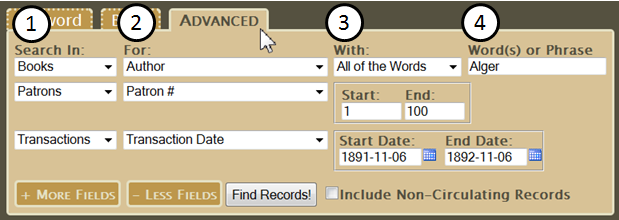 Input up to 10 terms for your advanced search. Note that the search input area will change depending on the type of field being searched
Input up to 10 terms for your advanced search. Note that the search input area will change depending on the type of field being searchedThe third tab of the What Middletown Read search engine opens the Advanced Search function. It allows users to complete searches using any combination of terms across all parts of the database. Proceeding left to right, the steps to an Advanced Search are as follows:
Where to Look? − 'Search In'
Specify which record group to search. Available choices are 'Books', 'Patrons',and 'Transactions'.
Which Field? − 'For'
Specify which field within the given record group to search. Available options will vary based on the value specified in 'Search In' section.
How to Match − 'With'
This field allows you to specify how your terms are matched. The choices are as follows:All of the Words
All terms specified in the 'Word(s) or Phrase' section must be present within the given 'For' field. The majority of web search engines use this behavior by default.
Any of the Words
At least one of the terms specified in the 'Word(s) or Phrase' section must be matched within the given 'For' field. This is the most generous matching option, and can be useful for tracking down particularly elusive records.
Exact Phrase
Must contain the terms entered in the 'Word(s) or Phrase' section exactly as entered within the given 'For' field. This is the most stringent matching option which should only be used when certain of the term(s) being specified.
None of the Words
The term(s) specified in the 'Word(s) or Phrase' section must not be present within the given 'For' field. This option is particularly useful for weeding out unwanted results.
Note that certain fields, such as dates and numbers, may not require a matching option. If a matching option is not required for a particular search, it will not display on the screen for the given row.
Term(s) − 'Word(s) or Phrase', Others
The final column in an advanced search allows users to specify the terms they wish to for which they wish to search within the database. Searches within date or numerical fields will present two input areas allowing for ranged searching. When possible, dropdown menus containing existing terms are provided. For fields with typing input, suggestions will appear as you start typing.
Repeat these steps for each term to be added to your search. One may currently combine up to 10 terms, from any variety of fields and sources, per advanced search. To display additional fields for searching, click on the 'More Fields' button. Clicking on 'Less Fields' will likewise reduce the number of terms in your search.
Search Tips: Subject Search
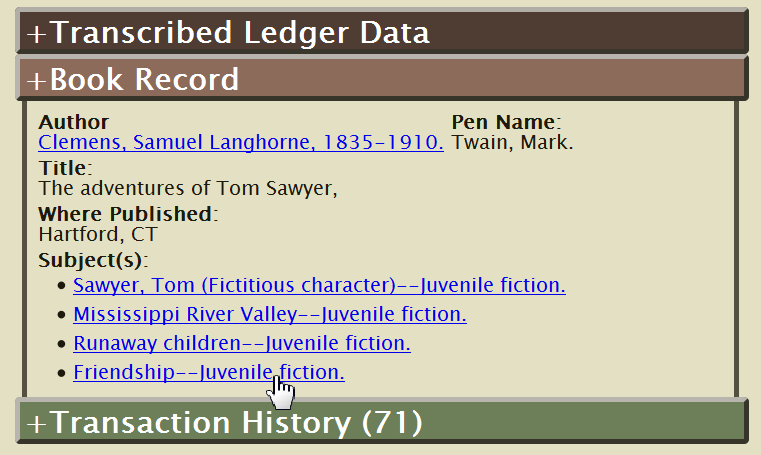 The 'Subjects' section contains live links to search for other records referencing works with the given subject.
The 'Subjects' section contains live links to search for other records referencing works with the given subject.Individual book records include Library of Congress subject headings, which appear as live links. Users can simply click on the subject heading to execute a search for all records that involve books that include that subject heading in their records. Results will include all such books, as well as the patrons who checked them out and the circulation transactions involved. It is also possible to execute a subject search by using the subject search fields available in both the basic and advanced search pages.
Search Tips: Search By Occupation Classification
 Use the 'Occupation Classification' field in Advanced search to look for patrons based on the grouping of their occupation. Also available in Basic search.
Use the 'Occupation Classification' field in Advanced search to look for patrons based on the grouping of their occupation. Also available in Basic search.The WMR database offers users the opportunity to employ two levels of occupation groupings when searching the MPL records. Project staff classified the occupational listings for 2,580 library patrons. To do so they employed the scale first developed by Alba Edwards. [See Alba M. Edwards, "A Social Economic Grouping of the Gainful Workers of the United States," Journal of the American Statistical Association 27 (1933).] This scheme, which has been adopted and modified by a succession of scholars, remains a useful tool for grouping late nineteenth and early twentieth century occupations. This breakdown simply splits occupations into blue collar and white collar sets. A second, more expansive system further breaks down occupations into 5 groupings: High White Collar, Low White Collar, Skilled, Semi-Skilled/Service, and Unskilled/Menial Service. The option to search these classifications is presented in both the 'Basic' and 'Advanced' search forms under the 'Occupation Classification' field. In both cases, drop down menus with available options are provided for user convenience.
Other Search Tips
Foreign Born/U.S. Born Searching
To find all individuals born outside of the U.S. input 'Foreign Born' into any birthplace search field−'Birthplace' in 'Basic' search, and 'Place of Birth' in 'Advanced' search. Likewise, to find all U.S. nationals input 'U.S. Born' into any birthplace search field.
Returning to Prior Searches
To return to a previously performed search, click on the 'Return to Previous Search' button above the search results section. To move forward to a more recent search, click on the 'Forward to Subsequent Search' button.
Browsing
Books/Patrons−
To browse through book or patron records, go to the 'Advanced' search form and input a range for the record's respective identifier−'Accession Number' for books, and 'Patron Number' for patrons. Approximate valid ranges are: 1−15,000 for Accession Number and 1−6500 for Patron Number.Transactions−
To browse through available transaction records, go to the 'Basic' or 'Advanced' search form and input a date range for the 'Transaction Date' field. This will display all available transactions for the specified time period.
Viewing/Downloading Results
Display
After a search query is submitted results will appear as a list of tabs at the bottom of the page, divided into following three categories: Books, Patrons, and (circulation) Transactions. Each result tab will list the type of result (ex: 'Book') along with the number of results within them listed in parentheses. Click on each tab to view the corresponding records produced by a search query. Alternatively, to display all results, click on the 'Show All' link to the upper left hand corner of the search results header. These results can be further analyzed with spreadsheet programs such as Excel or statistical software packages such as SPSS.
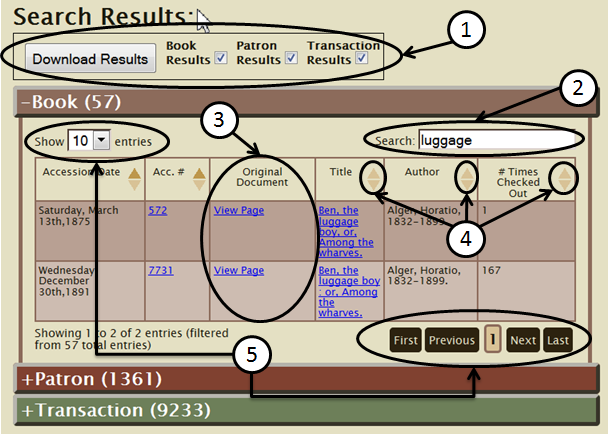 This image highlights some of the features available including: 1. Downloading Results, 2. Filtering, 3. Original Document Links, 3. Sorting, and 4. Pagination
This image highlights some of the features available including: 1. Downloading Results, 2. Filtering, 3. Original Document Links, 3. Sorting, and 4. PaginationFeatures:
Downloading Results
To download search results to a spreadsheet-friendly format (.CSV), select the results you wish to download by checking the boxes corresponding to each result type at the top of the results section--all results are selected by default. After selecting the results to download, click the 'Download Results' button to begin your download. Results will be downloaded in their original sorting order.
NOTE: Large result sets may take some time to download. Allow time for the download to complete before clicking the 'Download Results' button again.
Filtering
Users can filter all search results. To do so, enter the desired search terms (words or numbers) in the "Search" field in the upper right hand of the results display. Only those results which contain the desired term(s) will be displayed in the tabulated results.
Original Document Links
All results entries include a "View Page" link that leads to a scanned version of the page within the original document from which the corresponding record's information was drawn.
Sorting
Each type of result has a default sorting order, which can be altered at will. To sort on a single field, click at the top of a column (near the field's name--ex: Accession Date). The first click will result in an ascending sort. Clicking again will result in a descending sort. If uncertain of current sort settings, examine the directional arrows beside each field name. To sort on multiple columns, hold down the shift key as you click on each column you wish to sort by. The same rules for ascending/descending order apply.
Handling Large Result Sets (Pagination)
Each result set also has the option of setting how many results are displayed at any given time. One may display 10, 25, 50, or 100 results at once. The default is 10 entries per 'page'. Results larger than the current display limit are split into 'pages'. To navigate among pages, use the navigation buttons at the lower right corner of each result set. Text in the lower left will indicate your current location within the list of results.
Interpreting Book Results
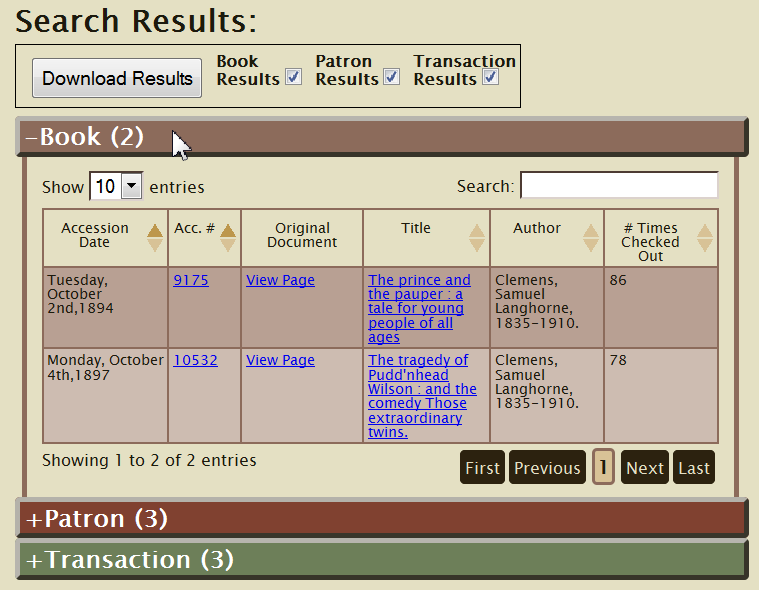 The book results tab contains search results relevant to books. Only a brief view of available book information is displayed. To view the full record, click on a link under the 'Accession #' or 'Title' column.
The book results tab contains search results relevant to books. Only a brief view of available book information is displayed. To view the full record, click on a link under the 'Accession #' or 'Title' column.The first results tab, labeled "Book", displays the list of book records corresponding to the query submitted. The columns for book results are as follows:
- Accession Date
- The date the book was first placed into circulation.
- Acc. # (Accession Number)
- The reference number assigned to the item by library staff.
- Original Document
- Link to original source material as mentioned in 'Viewing Results' section.
- Title
- The title of the work. A standardized version of the title is displayed when possible.
- Author
- The name of the author of the work. A standardized version of the author's name is displayed when possible, as well as any pseudonyms.
- # Times Checked Out
- The number of occurrences in which the given work was loaned to a patron.
Clicking on the 'Acc. #' or 'Title' columns will open the full record for the corresponding entry in a new browser window. See the 'Viewing Individual Records' section for more information.
For information on result features such as filtering and sorting, see the 'Viewing Results' section above.
Interpreting Patron Results
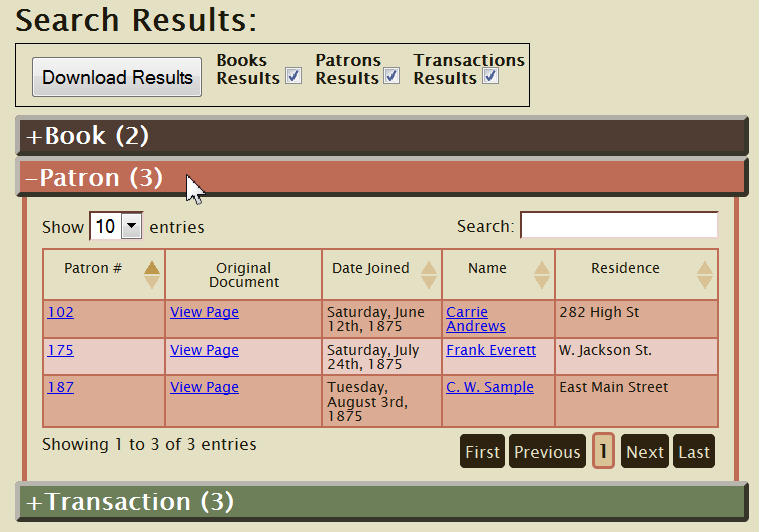 The patron results tab contains search results relevant to patrons. Only a brief view of available patron information is displayed. To view the full record, click on a link under the 'Patron #' or 'Name' column.
The patron results tab contains search results relevant to patrons. Only a brief view of available patron information is displayed. To view the full record, click on a link under the 'Patron #' or 'Name' column.The second results tab, labeled 'Patron', links to the list of library patrons corresponding to the search query submitted. The columns for patron results are as follows:
- Patron #
- The reference number assigned to the patron by the Muncie Public Library.
- Original Document
- Link to original source material as mentioned in 'Viewing Results' section.
- Date Joined
- The date the patron originally became a member of the library.
- Name
- The name of the patron. A standardized version of the name is displayed when possible.
- Residence
- The address where the patron resided.
Clicking on links under the 'Patron #' or 'Name' columns will open the full record for the corresponding entry in a new browser window.
For information on result table features such as filtering and sorting, see the 'Viewing Results' section above.
Interpreting (Circulation) Transaction Results
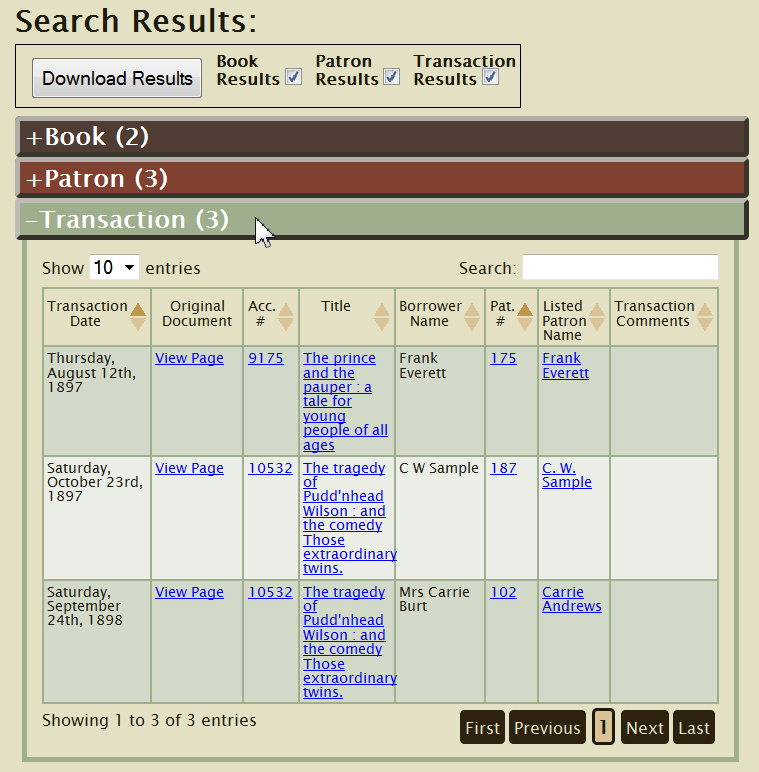 The transaction results tab contains search results relevant to circulation transactions. All available transaction information is displayed, along with brief information about the involved book/patron. To view the full record for the corresponding book, click on a link under the 'Acc. #' or 'Title' column. Likewise for the patron record, click a link under the 'Pat. #' or 'Listed Patron Name' column.
The transaction results tab contains search results relevant to circulation transactions. All available transaction information is displayed, along with brief information about the involved book/patron. To view the full record for the corresponding book, click on a link under the 'Acc. #' or 'Title' column. Likewise for the patron record, click a link under the 'Pat. #' or 'Listed Patron Name' column.The third results tab, labeled "Transaction", lists the circulation transactions corresponding to the search query submitted. The columns for transaction results are as follows:
- Transaction Date
- The date on which the specified book was loaned to the listed patron.
- Original Document
- Link to original source material as mentioned in 'Viewing Results' section.
- Acc # (Accession Number)
- The assigned reference number of the book which was loaned out for circulation.
- Title
- The title listed for the book, based on listed accession number.
- Borrower Name
- The name provided to library staff by the patron for checking out materials.
- Pat # (Patron Number)
- The number provided to library staff by the patron for checking out materials.
- Listed Patron Name
- The actual name listed under the provided patron number. Useful for determining instances of 'borrowed cards' (see Data Overview: "Borrowed Cards").
- Transaction Comments
- Comments regarding the entry in the ledger, such as notes on handwriting interpretation or notes left by library staff in original document.
Due to their nature, no individual record view is available for transactions. Clicking on the 'Acc #' or 'Title' will lead you to that book's full record. Clicking on the 'Pat #' or 'Listed Patron Name' will likewise lead you to that patron's full record.
For information on result features such as filtering and sorting, see the 'Viewing Results' section above.
Book Records
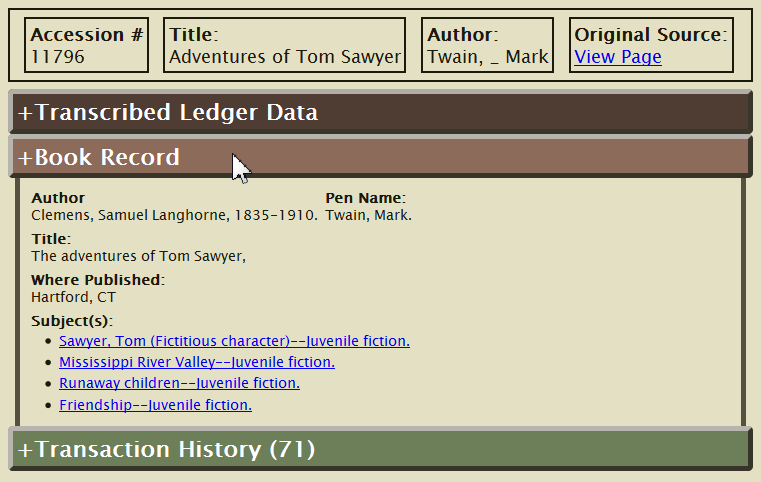 A typical book record. 'Transcribed Ledger Data' holds information retrieved from the library's original records. 'Book Record' holds standardized information such as known pen names and subject listings. 'Transaction History' holds all known circulation transactions for the title.
A typical book record. 'Transcribed Ledger Data' holds information retrieved from the library's original records. 'Book Record' holds standardized information such as known pen names and subject listings. 'Transaction History' holds all known circulation transactions for the title.Individual book records include three sets of data, presented in three tabs. The first, "Transcribed Ledger Data", opens to present the information included in the Accession Catalogue for that title. The second tab, "Book Record," opens to present information drawn from publicly available bibliographic records available through the Library of Congress and other sources. Whenever possible, this section lists information about the exact version of the book or magazine that was held in the Muncie Public Library collection. The third and final tab, "Transaction History," presents the circulation data for the title in question.
Patron Records
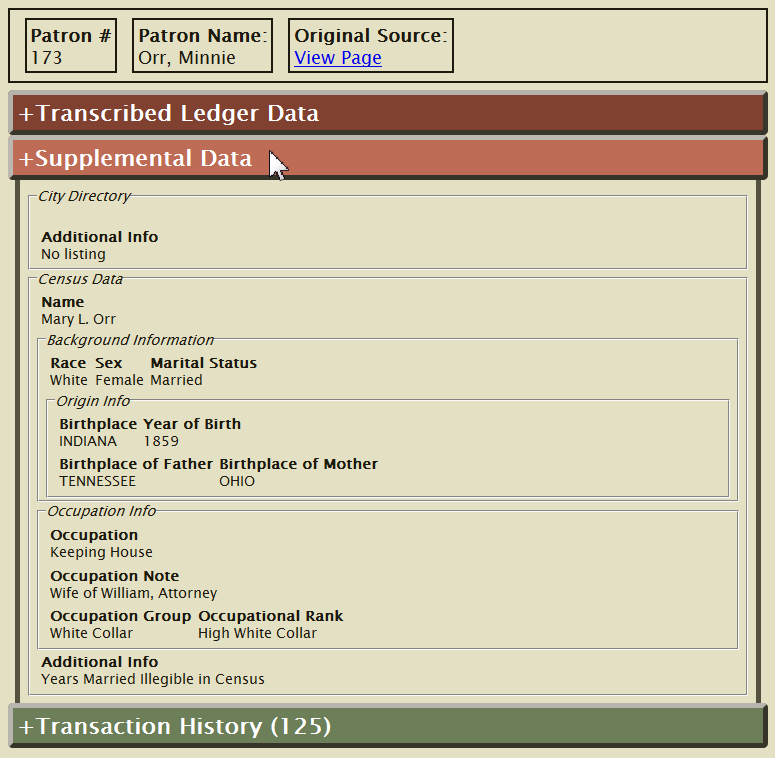 A typical patron record. 'Supplemental Data' holds information retrieved from the U.S. census and Muncie city directories. 'Transcribed Ledger Data' holds information recorded from the Book Borrowers Register.'Transaction History' holds all known circulation transactions for the patron.
A typical patron record. 'Supplemental Data' holds information retrieved from the U.S. census and Muncie city directories. 'Transcribed Ledger Data' holds information recorded from the Book Borrowers Register.'Transaction History' holds all known circulation transactions for the patron.Individual patron records are divided into three sets of data, contained within three tabs. The first, Transcribed Ledger Data, opens to present the information included in the Book Borrowers Register for that patron. The second tab, "Supplemental Data," opens to a section that includes information drawn from City Directories and the 1900 U.S. Census manuscript, whenever such information was available. The final section, Transaction History, includes all of the circulation transactions involving the patron (or patron number) in question.
(Circulation) Transaction Records
Due to the cumulative nature of transaction records, no individual record view is available. All available information for a given transaction record is listed in the transaction search results. For further information on the title or patron involved, click on their respective links within the transaction results table.

